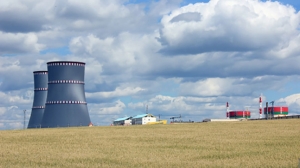Belarusian nuclear power plant safeguards explained

MINSK, 9 September (BelTA) – The Belarusian nuclear power plant is designed to deal with all kinds of emergencies and accidents, BelTA learned from Nikolai Karpenko, Lead Engineer for Safety Analysis of the Reliability and Safety Analysis Department at the state enterprise Belarusian Nuclear Power Plant, at a press conference on 9 September.
The engineer said: “The design of the Belarusian nuclear power plant and the safety concept are meant to rule out all kinds of emergencies. If we talk about severe accidents, their probability is exceedingly small. Equipment, safeguards, and components of the nuclear power plant minimize the probability of such accidents. However, in light of the lessons taught by the Fukushima nuclear power plant we are also ready for such scenarios.”
In his words, the concept of a multitier safety system is being implemented. “At every level we have technical solutions for dealing with an accident regardless of how far the accident has progressed. Our nuclear power plant has reliable supplies of electricity. It cannot be flooded. The heat dissipation system relies on passives. The Belarusian nuclear power plant also has a unique technical solution in the form of a core catcher. We also have universal instructions that cover all the possible ways of development of accidents,” the lead engineer noted.
The Russian design AES-2006 has been chosen for building the nuclear power plant in Belarus. The design meets modern norms and safety standards, Nikolai Karpenko reminded. “If we talk about the stress tests procedure, we've received positive results as a result of evaluation by European experts. The relevant report is available to the general public. Moreover, the European experts mentioned positive practices implemented by the Belarusian side,” Nikolai Karpenko stressed.
A national action plan was prepared in the wake of the stress tests. It summarized recommendations produced as a result of a national expert evaluation and recommendations given by experts in the course of a European peer review. The document lists 23 measures and events to be implemented by 2025. Some of them require additional analytical work, work of scientists and experts. Some are recommendations that focus on systems and equipment of the Belarusian nuclear power plant.
A number of measures have already been implemented, including those relating to additional safety-enhancing systems and equipment. In particular, a movable diesel generator was delivered to the Belarusian nuclear power plant site. The diesel generator will be permanently on standby and will ensure the operation of the safeguards of the first unit if necessary. Similar solutions will be implemented for the second unit. Apart from that, the replenishing of tanks for passive reactor heat dissipation systems was successfully tested. These systems are designed to deal with accidents beyond the design basis and can siphon off residual heat from the reactor core via steam generators if the nuclear power plant experiences a total power outage.
The Belarusian nuclear power plant is being built near Ostrovets, Grodno Oblast using the Russian design AES-2006 featuring two VVER-1200 reactors with the total output capacity of 2,400MW. The Russian state nuclear industry corporation Rosatom is the general contractor.
On 23 June 2011 Belarus voluntarily signed the declaration of the European Nuclear Safety Regulators Group (ENSREG). In accordance with the document Belarus undertook to organize stress tests of the Belarusian nuclear power plant in line with methods of the European Union. The stress tests evaluated the availability of safety margins in excess of those required by the national legislation. Criteria of the stress tests included checking the nuclear power plant's resilience to natural phenomena, in particular, earthquakes and floods, as well as various man-made accidents.













